
Please send all Checks and Money orders to :
Dave Taylor P.O. Box 87 Sylvania, OH 43560
419-842-1863
Click Here to E-mail Us!
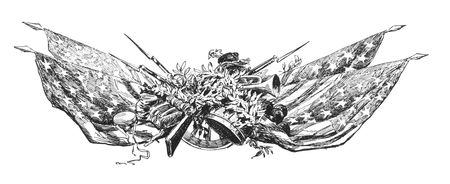
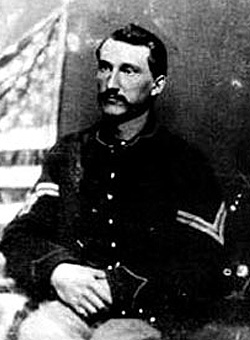
15 06
LAYAWAYS ARE WELCOME:
Need to split your order into multiple payments? No problem! A simple 20% earnest money deposit will hold your item for you.
You can then pay it off in easy installments that fit your budget.
Read Terms Here
~~~~~~~~~~
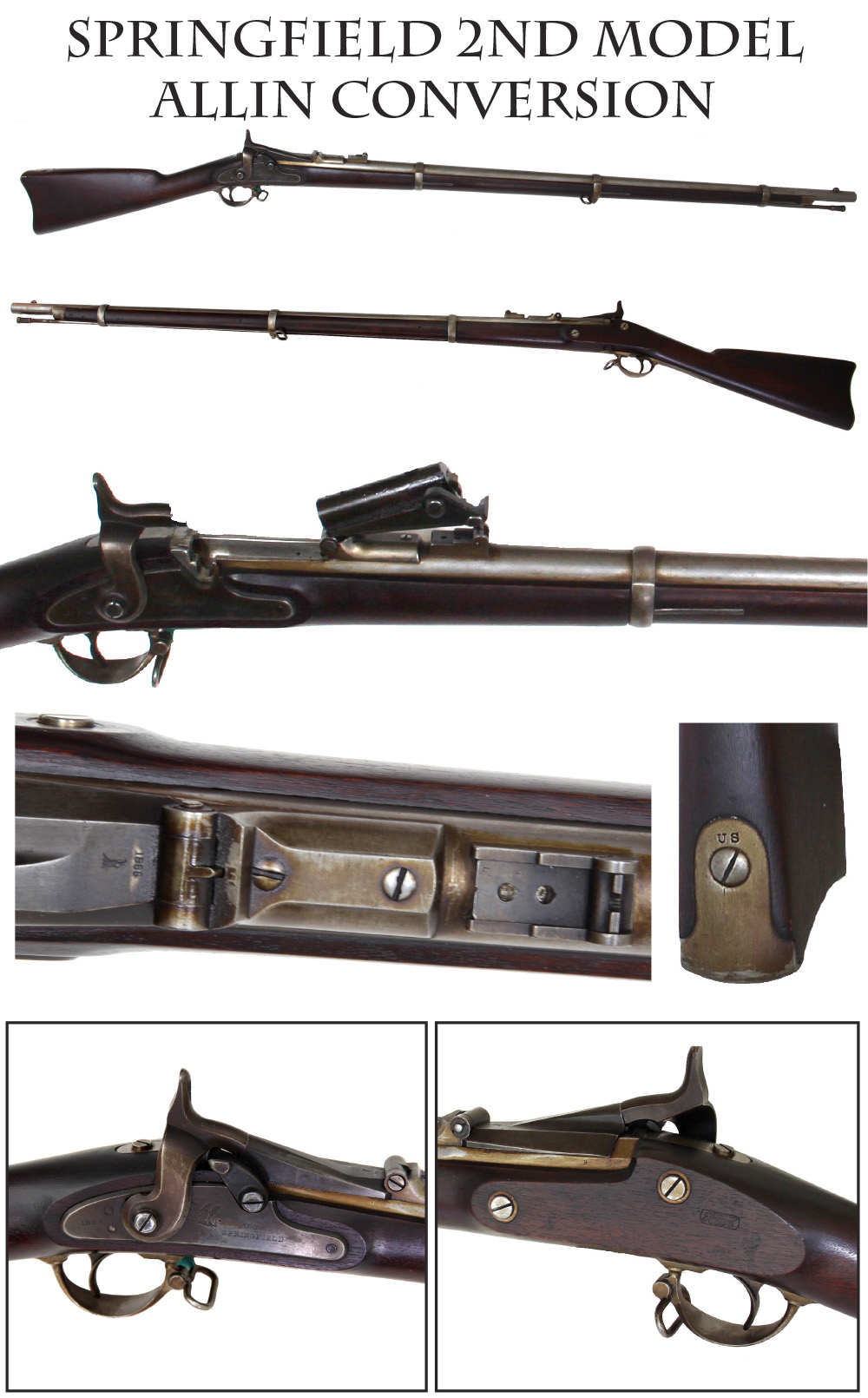
15-06-01 … Excellent “Minty” Condition Springfield Second Model Allin Conversion …
Also known as the Model 1866, this was the gun that really won the west. About 25,000 of these rifles were made starting in 1866 using Civil War rifle barrels bored out and lined for .50 caliber centerfire ammunition. Correct 1866/Eagle breechblock with an 1864 dated Springfield lock. As issued barrel, bands, etc in the bright, with correct dark oil-quenched case color on the block and brighter water-quenched case colors still showing on the lock and hammer. Sharp edges to the lock apron and the offside flat with a crisp cartouche in the wood. Cleaning rod, bands, springs, swivels, front sight and correct backward facing rear sight all in place. When troops went west after the Civil War this was the weapon most of them carried until the .45-70 rifles were issued in 1873, and even then many of these large bores remained in service for a time thereafter. Early Hagner cartridge pouches were set up for .50 caliber rounds and even as late as the Little Big Horn there are references to officers preferring the big punch of a .50 round for their personal longarms. You will be hard-pressed to upgrade this rifle, and will likely never have to. Priced friendly
… $1,750.00 – SOLD
Click Here to E-mail Us!
Call us @ 419-842-1863

15-06-02 … Engraved Clauberg Officer’s Sword …
High Grade Silver Hilt Presentation Grade Field Officers Sword by Clauberg: Very impressive field grade sword with heavily embossed German silver grip and ornately worked pommel, guard and scabbard mounts with a panel mounted between the upper mounts to take a presentation plaque. Deeply worked gilt brass pommel with bearded face below the pommel cap, floral motifs in the guard along with a US eagle, spread-winged with shield on its chest and ribband in its beak, and a quillon in the form of an eagle’s head as well. Grip still has wire running in the grooves and embossed floral motifs on alternating raised ribs. Leather washer in place at blade shoulder. Correct “W. Clauberg/ Solingen” with standing figure mark at the ricasso. Blade etching is light, blade is mostly bright mixed with gray and some dark spots, particularly midway down on the inboard side and toward the tip on both. Metal scabbard shows attractive color, plum with one or two minor corrosion spots that blend in well and are not noticeable. The mounts are particularly impressive, matching perfectly the hilt when the sword is sheathed: the lower mount with an openwork drag and geometric and floral motifs, the middle mount with geometric design on one side and on the other a mounted figure at the gallop. The upper mount shows a standing soldier with musket and a draped background, heavy raised borders to the top and bottom, and joined to the middle mount by the open frame for a plaque. Matching heavily worked brass throat piece also in place. A very impressive officer’s sword, an expensive product at the time, obviously intended for a presentation to a respected officer. This would dress up any officer’s display as well as be a target for sword collectors. A true work of art and priced like a gift!… zbb-eber
… SOLD
Click Here to E-mail Us!
Call us @ 419-842-1863

15-06-03 … USN Navy Model 1843 and later Pistol Cartridge Box …
Very scarce cartridge box issued with the M1843 single shot .54 caliber Navy box lock pistols, and the Colt and Whitney 36 caliber revolverrs. The differences between the boxes are largely the tin liners inside. This box has no liner but the interior size appears to be correct for the six compartment tin for packets of skin cartridges as opposed to the tin for the larger caliber paper cartridges for the USN Box=Lock pistol. Overall VG to near fine condition. Richly embossed USN on the front flap. Marked “Navy Yard NY 1864” on the inner flap. All straps and flaps complete and solid. Lacks tin liner only. A key piece for the CW accoutrement display, and not easily found
… $595.00 – SOLD
Click Here to E-mail Us!
Call us @ 419-842-1863

15-06-04 … Cap Box with U.S. Stamp on Cover:
Early pattern with abbreviated outer flap similar in design to the Mexican War cap boxes. This one stamped US on the outer flap. Completely sewn construction. No rivets used … hence an early war or pre war specimen. Overall VG + condition
… $165.00
Click Here to E-mail Us!
Call us @ 419-842-1863
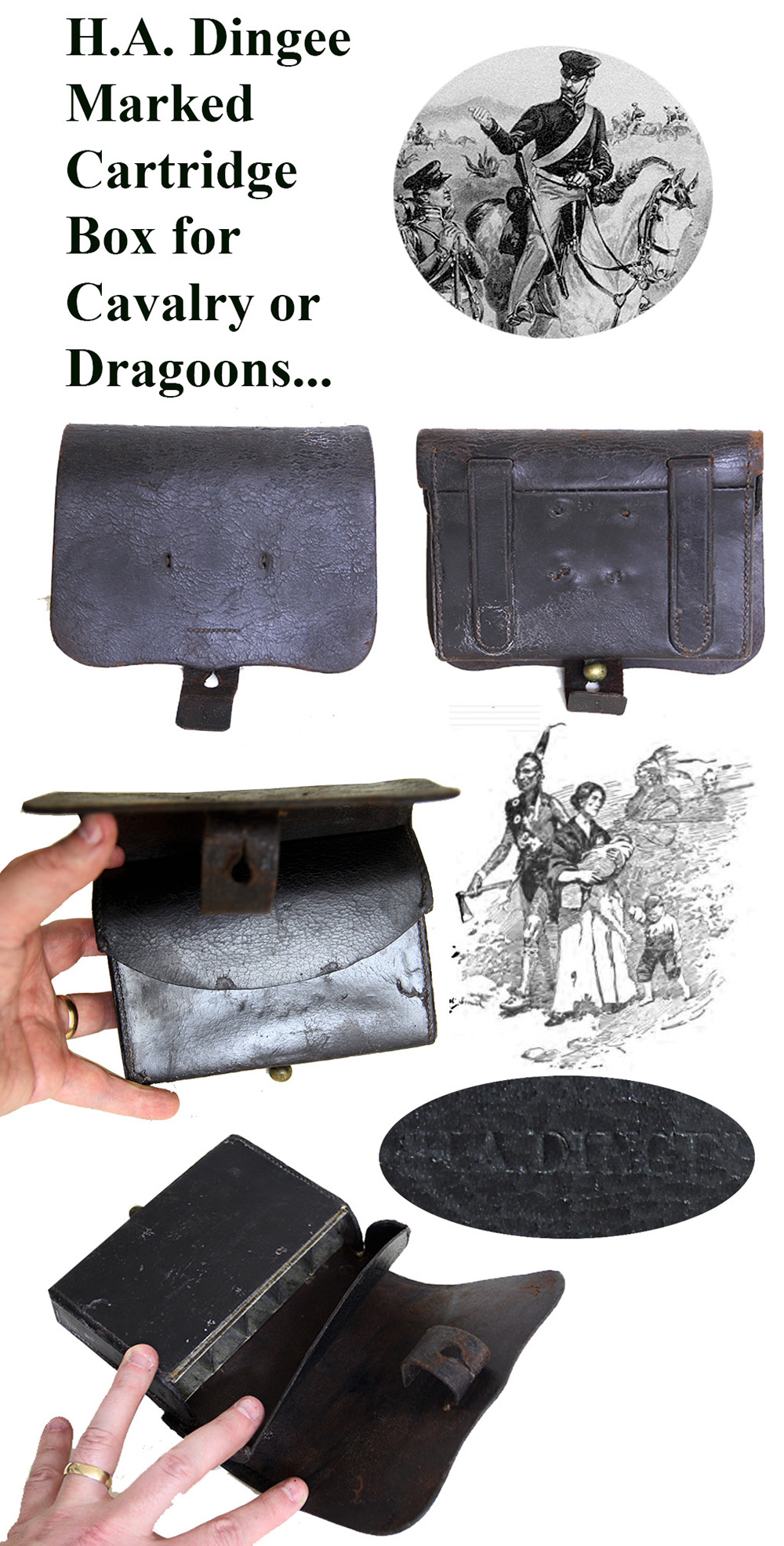
15-06-05 … Rare Mexican War Dragoon Model 1839 Pistol Cartridge Box Maker Marked DINGEE , Complete With Tin Liner:
This Model 1839 Pistol Cartridge Box, was issued with the M1842 Aston and Johnson Pistols, and was undoubtedly used with the M1836 conversion pistols as well. It features a single tin insert with two lower compartments for full packets of ammunition and 5 smaller compartments in the upper section of the tin. The five upper sections each hold four individual .54 caliber rounds. As described in the 1841 Ordnance Manual, the body of the box measures 6.2 long, 1.3 wide, and 3.5 high, is double flapped and has no implement pouch on the front of the body. Overall VG to fine condition. All flaps and straps are firmly in place. The interior flap bears the lightly struck maker’s stamp, H.A. DINGEE . Two slits on the front flap show where the oval US plate once resided. We may be able to supply one… call to ask. Finding these with the proper tin liner is an incredibly rare event, most surviving specimens have no liner, or a later liner. These are the accoutrements used by our mounted troops on the western frontier … the Indian Fighters in Texas, California, Mexican War troopers, etc. … Extremely scarce
… $495.00 – SOLD
Click Here to E-mail Us!
Call us @ 419-842-1863
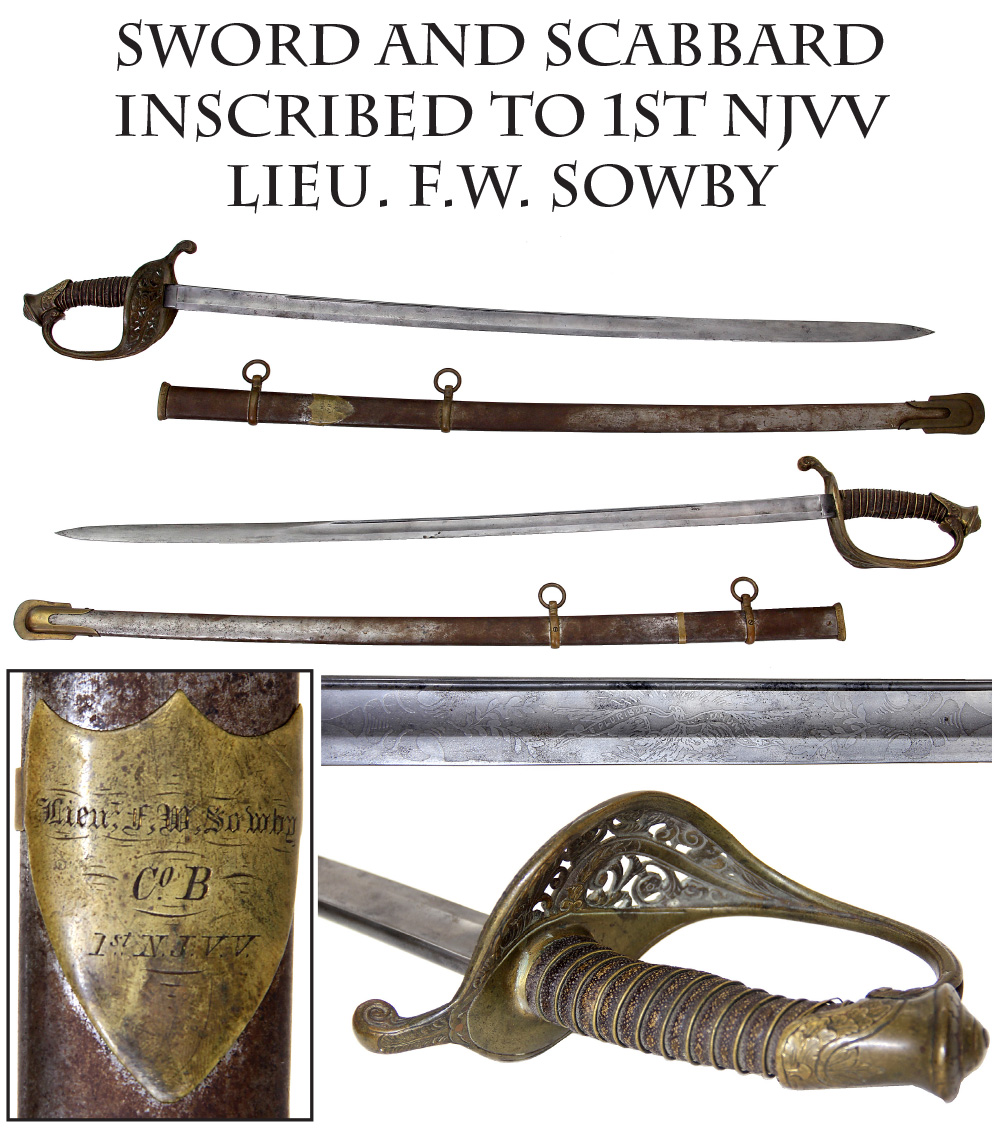
15-06-06 … New Jesey Inscribed Officer’s Sword:
1850 pattern foot officer’s sword in a brass mounted steel scabbard. Matching mellow patina to all the brass- untouched with some dark areas. Down-turned pommel that suggests Sauerbier as a maker or dealer, but has a stopped fuller and sharkskin grip. Grip good with just wear and rubbing to high spots from use. Single thick wire binding, one small piece of a thinner bordering wire near the pommel. Scabbard silver gray turned brown for about two thirds the length. Brass throat, carrying rings and drag in place. Between the upper mounts is a separate brass shield shaped plaque held by a band, nicely inscribed: “Lieut. F. W. Sowby / Co. B / 1st N.J. V.V.” in Old English and block letters.
CWData shows two men named F.W. Sowby, but there was only one, serving in the 3rd New Jersey, and then joining the 1st New Jersey Veteran Battalion (or “1st NJ Veteran Volunteers”) which consisted of the consolidated units. Sowby enlisted in the 3rd NJ in April or May of 1861, mustering in as a private in Company B and making corporal as of July 1, 1863. He served with them until 6/23/64 when he and the others who had reenlisted as veterans or had time left to serve were transferred and he joined Company B of the 1st NJ. He was commissioned 2nd Lieutenant 2/2/65 and 1st Lieutenant 5/11/65, mustering out 6/29/65. Sowby would have seen a lot of action. Both units were Army of the Potomac, 1st and 6th Corps. The 3rd, in particular, took heavy casualties at Gaines Mill, Cramptons Gap, Salem Heights, and Spottsylvania during Sowby’s service, and the 1st saw action at Winchester, Cedar Creek, and Petersburg. The blade is a smooth silver gray, rubbed on one side, but with very visible etching and a nice eagle with E PLURIBUS UNUM ribband on the other. No maker or dealer markings, but a dead-real inscription and an interesting sword carried by a soldier who saw a lot of fighting … aejj
… $2,350.00
Click Here to E-mail Us!
Call us @ 419-842-1863

15-06-07 … Pittman Marked Cavalry Cartridge Box …
Regulation issue cartridge box for the cavalry carbine. These boxes were issued to troopers for use with many different carbines. A wood block bored with twenty holes kept the rounds intact while the trooper was galloping around and an inner and outer flap kept them dry and in place. This block is not present in this box. Until very late in the war the boxes still had provision for a shoulder strap, but they seem to have always been worn on the waist belt and occasionally the carbine sling. This one was actually issued and carried: two slits in the cover show where a trooper at some point added a cartridge box plate. Both belt loops, the cross-loop, and the latch tab are in place. Both buckles are there, but the tab securing one has a tear on one side. Crackling and some loss to the exterior finish, the interior is good. Very clear Pittman stamp. Tool pouch, flap and tab are intact. A pretty basic, and essential, cavalry accoutrement pouch
… $185.00
Click Here to E-mail Us!
Call us @ 419-842-1863
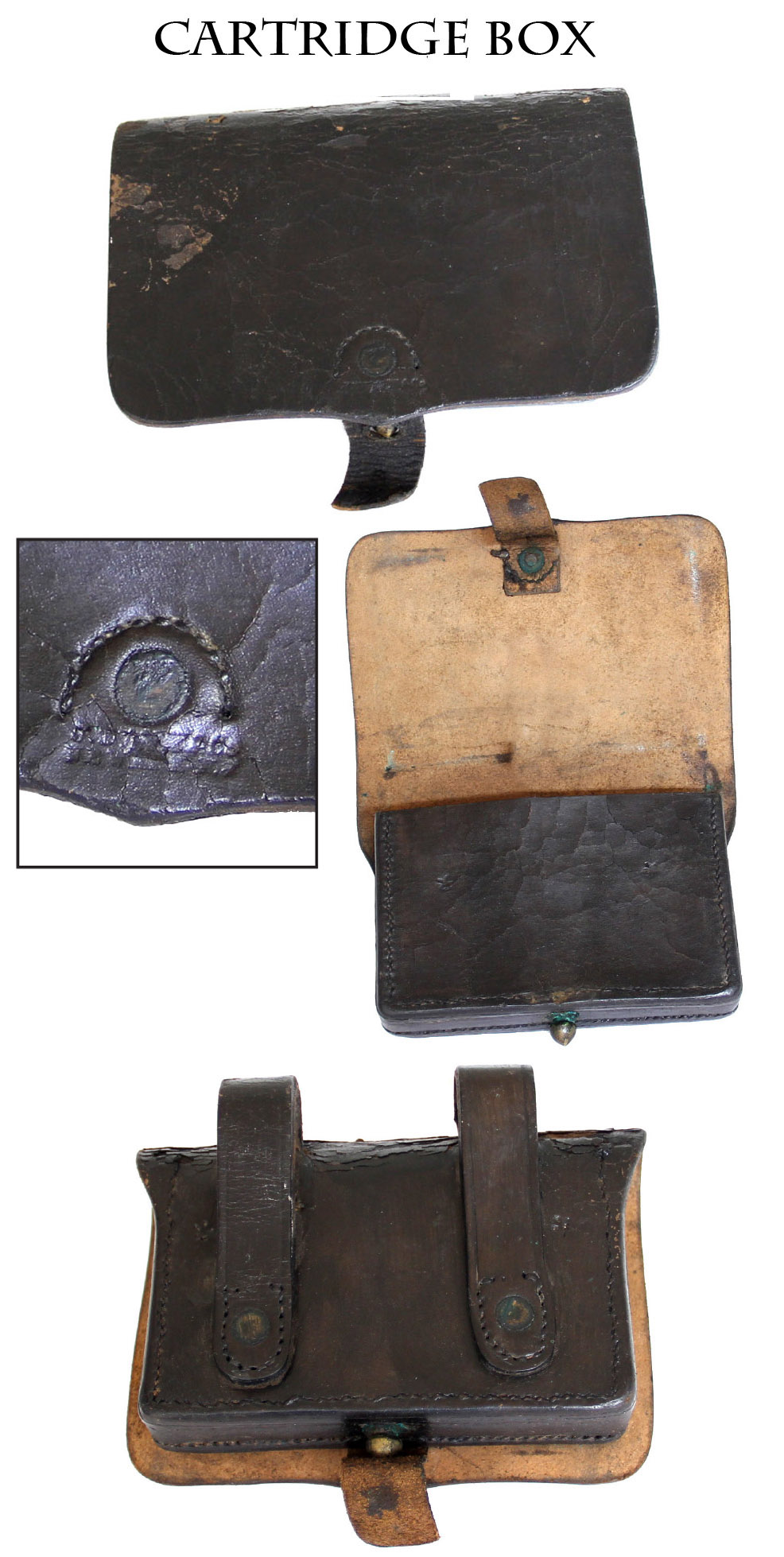
15-06-08 … J. Davy & Co. U.S. Cavalry Pistol Cartridge Box …
A .36 or .44 Caliber revolver was an essential sidearm issued to cavalrymen, and the ammunition was carried separately from the carbine rounds. These smaller pouches went through a couple of minor design changes but were largely identical. A single outer flap latched at the bottom and the box itself held two inner leather pieces that kept the cartridge packs in place by friction. The boxes show up in three different sizes that correspond to different configurations of the issue ammunition packs. This is a good mid-size and mid-war box showing a latch tab secured by a rivet and stitching, but with box not yet enlarged to handle pistol cartridge packs that contained percussion caps as well as cartridges. Some crackling and minor finish loss, but a clear J. Davy stamp at lower front under the rivet, with belt loops and latch tab solidly in place. Mixed black and brown tones
… $195.00
Click Here to E-mail Us!
Call us @ 419-842-1863
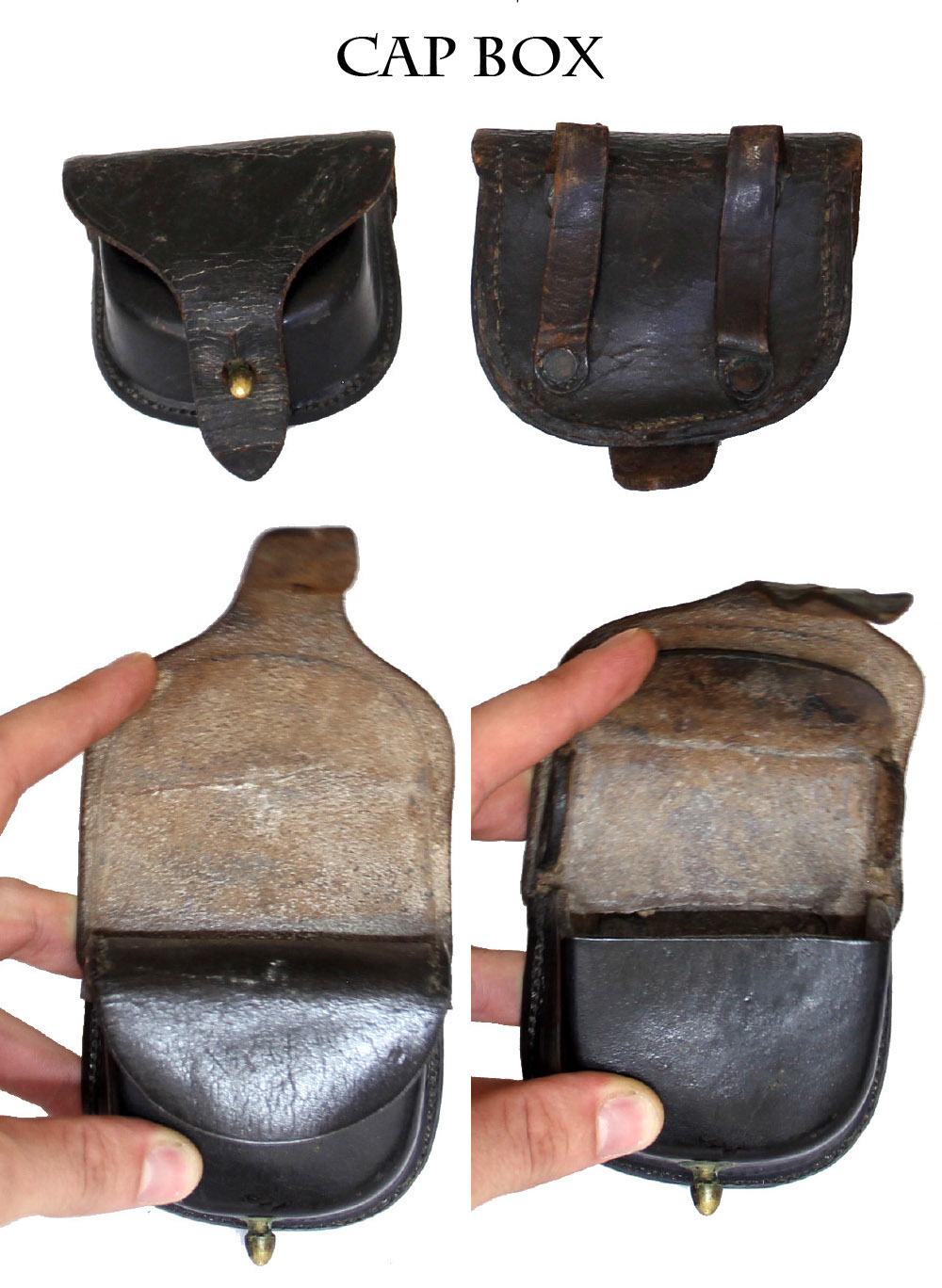
15-06-09 … Civil War Cap Box …
Nice example of the most recognizable Civil War accoutrement- the percussion cap pouch. When most weapons fired cartridges that required separate primers, every Civil War soldier probably had at least one of these issued to him during the war. Outer flap extending to pointed latch tab that fastens to a brass stud on the bottom, both belt loops in place, secured by stitching and rivets. Inner flap with “side ears” still attached that kept the caps in place if the box was left unlatched. These were issued with a strip of lamb’s wool stitched across the back to keep the caps from bouncing out along with a small wire vent pick. As is almost always the case these are long gone from wartime wear and postwar moths, though the picks occasionally show up on the loose. No maker marks, but the relatively long inner flap is usually a sign of early to mid-war manufacture. Minor crackling, but generally good finish
… $145.00 – SOLD
Click Here to E-mail Us!
Call us @ 419-842-1863

15-06-10 … Damascus 4-Barreled Mariette Patent Cased Percussion Revolver …
As I’ve mentioned a couple of times, I like examples of Victorian engineering genius applied to firearms, and I’m a sucker for small size pistols. Here is an elegant French-cased example of a marvelous Damascus four barrel pepperbox, marked “Mariette Brevete” on the grip strap with a ring-trigger, engraved receiver and four numbered Damascus barrels. This box is complete with its tools, including its bullet mold with matching serial number 662. All the metal is now bright, with some brown spotting around the breech assembly. Elaborate floral engraving runs up the backstrap of the bag shaped grips, and is continued on the receiver surrounded by a geometric border. Panels supporting the barrel breeches are likewise engraved with a circular motif, as are the screws on the super condition dark wood grips. The barrels have a lively and very visible Damascus twist, are slotted at the muzzles for dismounting, and are numbered in sequence 1 to 4, matching the breech assemblies. The nicely grained wood case has a handsome brass escutcheon panel inset on the lid and a keyed lock on the side. The velvet lining is embossed around the edge of cover pad and an even faded orange in tone that was likely red originally. There is just minor wear to the nap. The bullet mold casts one ball at time and the handles form tools for dismounting the nipples and the barrels. A small hard-rubber oil bottle and a round cap tin with paper label (about 90 percent intact) remain in their places, and a small covered compartment still has a couple of round balls in it. Two cracks across the lid, but it is stable. 3 inch barrels. Box measures 8 inches wide. An elegant early gun with infinite appeal … bcjj-16933
… $2,750.00
Click Here to E-mail Us!
Call us @ 419-842-1863
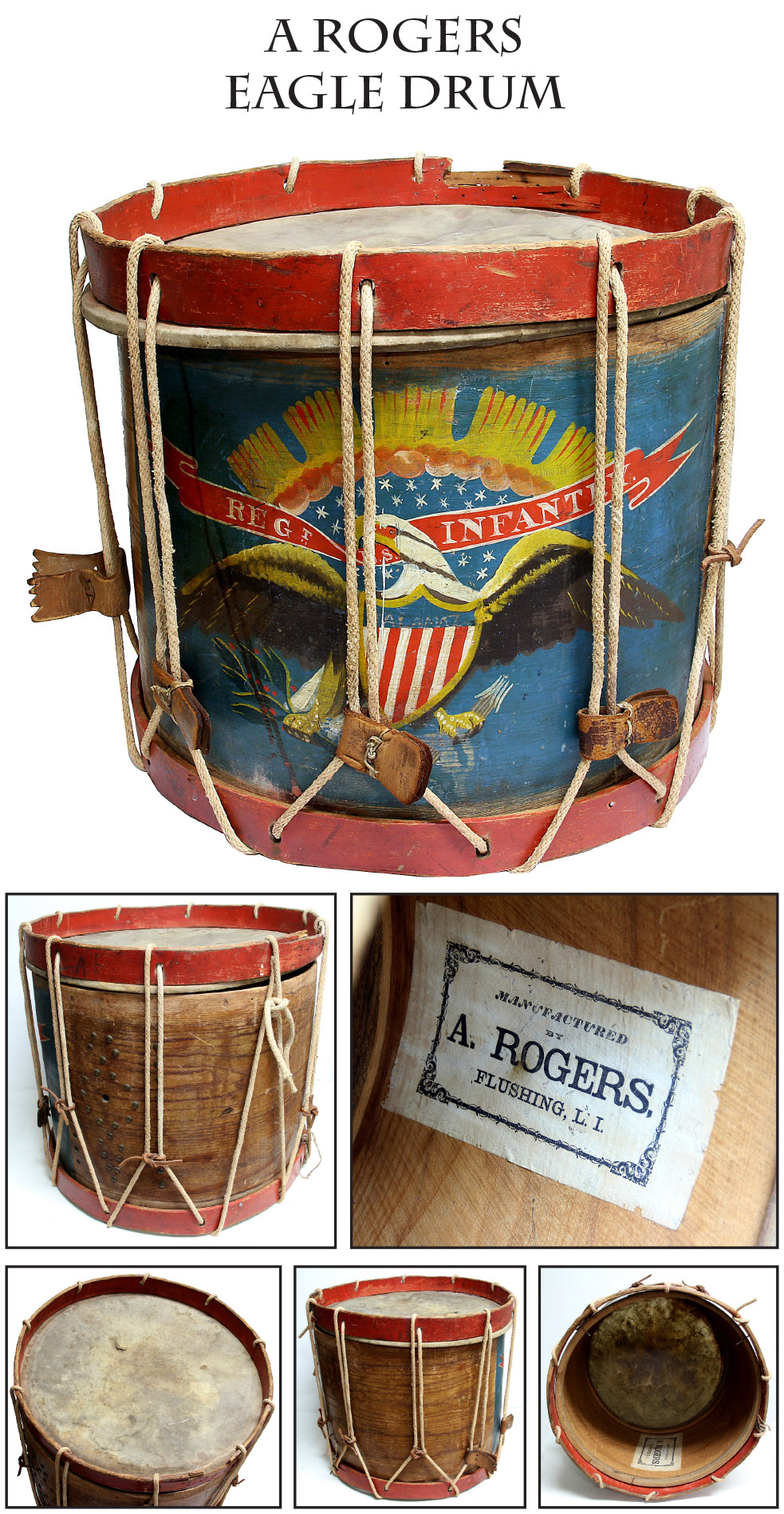
15-06-11 … Regulation Civil War Eagle Drum by A Rogers of Flushing L.I. U.S. …
Army eagle drums follow the same pattern as the arms of the United States. Per infantry regulation this is painted on a light blue panel. There were many makers each with their own version of the eagle. Rogers’s drums are among the more attractive, and this is a wonderful example. Rogers drums are good candidates for early-war use since he had seven contracts between from August, 1862 to September, 1863 for 1,900 infantry drums (and another three contracts for an additional 2,500 drums starting in 1864.) This one is full height (measuring 000 inches tall by 000 inches in diameter) and has bright original paint that has very minimal rubbing or loss. Just a very light shifting to green in a few spots on the corners of the blue panel, a little abrasion of the arrow shafts below the eagle’s left claw and above the olive branch in his right. A little wear across the upper tips of the central group of sunrays where the flesh hoop would have rubbed it when tightened, a few minor scratches and two light lines where something dripped down the left. Vivid yellows and reds, bright “Regt. U.S. Infantry” painted in white on the red ribband behind the eagle’s head. The plain wood section of the body shows finish loss, which is fine because it shows it was carried outdoors and also rubbed against the drummer’s body on the march. Nice full intact label: “Manufactured by A. Rogers, Flushing, L.I.” (Long Island.) Upper and lower rims in place with original paint. The upper rim with some cracking and wood loss at the overlap and showing wear along the top edge from the drummer’s sticks hitting it. Top head in place. The flesh hoop and rim are warped and the fit is askew. The bottom head, bottom flesh hoop, and the snare are gone, but could be replaced. I own numerous painted drums and do not restore them. They display like a million dollars and I have no interest in playing them. Four of the tighteners are original, though with replaced lacing. The other tighteners are replaced. The rope is the typical laundry cord pressed into service by many collectors- a correctly twisted hemp rose is readily available from Cooperman Fife and Drum among others, (as are replacement heads.) Someone has scratched “Salamaz” above the stripes of the shield on the eagle’s chest, suggesting additional postwar use by a fraternal organization.
All in all this is a very nice example of the regulation drum carried by company musicians in infantry regiments and retained in active field service even after regimental bands were largely done away with. A colorful piece of Americana, they have always been popular on the folk art market as well among Civil War collectors. These have always been desirable. In Francis Bannerman’s 1909 Catalog of Military Goods he priced one of these drums at $50 ! That was a mountain of money in 1909. Well over a month’s pay… Mint Remington revolvers were $3.95. Mint muskets were ten dollars or less. This one is reasonably priced
… $3,950.00
Click Here to E-mail Us!
Call us @ 419-842-1863

15-06-12 … Silver Plated Eagle Spurs …
Fancy commercially purchased officer’s spurs with eagle heads and wings spreading out to act as side bars. This is the style to be permanently attached to boot heels with a central pin driven into the heel and the wings secured with small screws. Made without rowels, the necks are cast in rounded rectangular section and chased with bands of feathers along the necks that spread out over the eagle’s claws grasping a short bar and then spread in larger feathers back over the wings. The eagles eyes and beak are detailed in profile, the top and bottom rounded edges being more lightly engraved. The right tip of one eagle’s wing is missing, but the others are intact and show the small screw holes. A nice dynamic set of eagleheads that would dress up an officer’s display immeasurably … ejjr
… $750.00 – SOLD
Click Here to E-mail Us!
Call us @ 419-842-1863
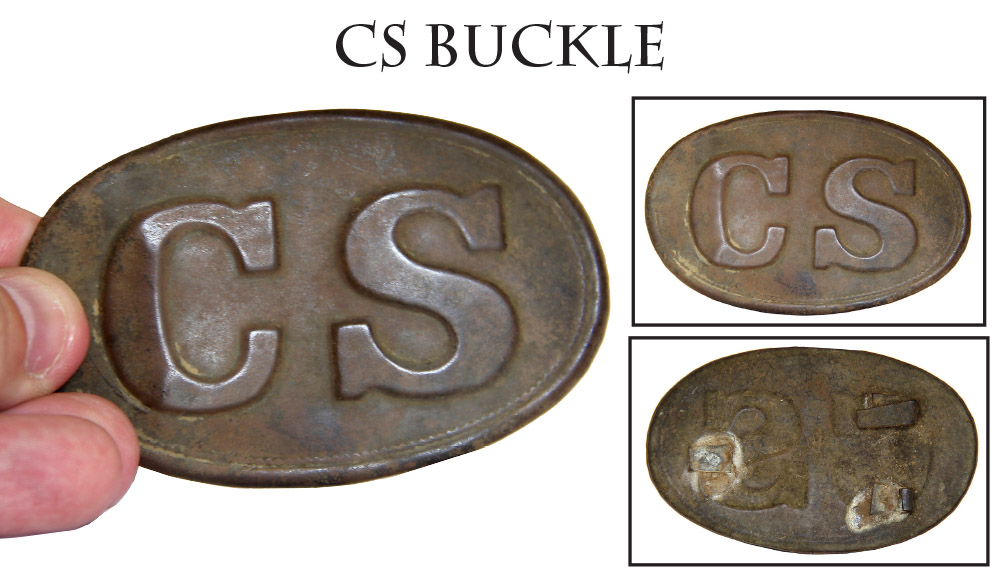
15-06-13 … Beautiful Oval CS Buckle …
“Rope border” oval Confederate belt plate. These plates are stamped brass and not filled with lead solder. The attaching hooks are soldered in place. This desirable buckle was issued to Confederate troops in the Army of Tennessee and other western troops starting in 1862. The hooks are made of flat scrap brass, sometimes trimmed from the stamped plate itself and soldered on the reverse. This was an efficient, if not robust design, and this buckle shows a not-untypical loss of two of the hooks that probably led to the plate’s loss by the Johnny Reb. This is an older battlefield pick-up, from the early days of metal detecting. It previously resided in the Steve Sullivan collection. Steve passed away a couple years ago. This plate has a great patina of milk chocolate brown … very uniform. Not only is the “CS” sharp and well defined, the edge is not battered and the inner beaded “rope border” ring that gives the plate its nickname is very visible and well defined. An iconic plate, dead real, not easy to find, and worthy of any good collection … zbejj
… $3,250.00 – SOLD
Click Here to E-mail Us!
Call us @ 419-842-1863

15-06-14 … 76th New York Identification Disc Present at Gettysburg And Wounded When The Iron Brigade Got Its Name …
A real fighting man’s identification disc. Before the U.S. Army issued dog tags the soldier himself had to provide his own means of identification if he wanted one. Most soldiers did, worried that if they were killed they would be buried in an unmarked grave. The I.D. discs insured that mom or dad or wife could be notified, and bring the corpse home. The Scovill Manufacturing Company stepped up and produced numerous designs of Identification Discs … the forerunner of the dog tag. The discs were sold by Sutlers directly to the soldiers. This is the “War of 1861” pattern disc with that motto above an eagle and “United States” below on one side, and the other side stamped with the soldier’s name, unit and hometown. This one is stamped, “J. I. Reese / Co. H /76th /Reg. /N.Y.S.V. / Sherburne.” Our man is Jacob J. Reese. He enrolled 11/26/61 at Sherburne when he was 24 years old. He signed up for three years and mustered into Co. H as a corporal as of 1/7/62. He made sergeant some time prior to April, 1863, and first-sergeant (the senior company NCO) 8/15/63. He re-enlisted as a veteran and must have been a capable soldier for he received a commission on 11/30/64 giving him rank from 8/18/64, and mustering him into Company B as of 9/30/64. He was discharged 1/28/65 when the last of the regiment was mustered out and men with time yet to serve were transferred to the 147th NY. The middle initial of “I” on the disc is a typo. In 19th century script the capital letters “I” and “J” are virtually identical. That is the reason the army did not allow the designation of Company “J” in any regiment. The designations went from Co. “I” to Co. “K” (skipping “J”) so that company and regimental records could not be confused. Our sutler read the name J. J. Reese as J. I. Reese, but the identification of our soldier is clear. This is likely an early war tag, purchased in camp near Washington in early 1862, and carried throughout all his engagements. A 76th NY collection broken up years ago had a few tags of this design and the common element was that they had belonged to soldiers with early service in the regiment.
The 76th NY was a hard-fighting unit in the Army of the Potomac, serving in the First Army Corps and then the Fifth Army Corps after the amalgamation of the two just before Grant’s overland campaign. Interestingly, the regiment and Reese have close associations with the Iron Brigade. Reese’s service record shows him to have been with the company during the Gettysburg campaign when they helped open the battle on July 1, as part of Cutler’s Brigade. Fighting alongside Meredith’s Iron Brigade, they suffered 5 officers and 43 enlistedmen killed or mortally wounded and another 116 officers and men wounded while fighting west of the town under General Reynolds.
Reese was twice wounded during his service, and on the first occasion was also serving alongside the Iron Brigade at Gainesville, an alternate name for the Battle of Brawner’s Farm during the campaign of Second Bull Run. On August 28, 1862, Stonewall Jackson moved some three brigades concealed in woods above the line of march of King’s Division of Federal troops and struck squarely John Gibbon’s brigade of western troops who proceeded to earn their nickname of the “Iron Brigade” in a long, bloody, toe-to-toe slugging match. The 76th New York, of Doubleday’s brigade, was one of just two regiments to come to their assistance, taking up position between the 6th and 7th Wisconsin. In one of the toughest fights of the war, they held their position against Jackson’s brigades, the 76th losing 30 killed and mortally wounded. Reese was among the wounded who survived and returned to service.
His second close call was 5/23/64 during Grant’s overland campaign. Now the company First-Sergeant, and the regiment part of the 5th Army Corps, Reese was wounded at the North Anna River when Warren led the 5th Corps across at Jericho Mills on May 23, but was stymied by Confederates under A.P. Hill. It may have been a lucky wound: more days of fighting ended inconclusively and the troops trudged off to Cold Harbor, and more slaughter.
Reese returned to New York after the war and apparently had trouble from his wounds. He filed for a pension in May, 1865. He died ten years later, in 1875 and is buried in Sherburne in the family plot that bears the alternate spelling “Rees.” A nice tag from a fighting regiment in the Army of the Potomac with plenty of opportunity for even more research. About as much history as you can hope to get on any identified artifact
… $995.00 – SOLD
Click Here to E-mail Us!
Call us @ 419-842-1863
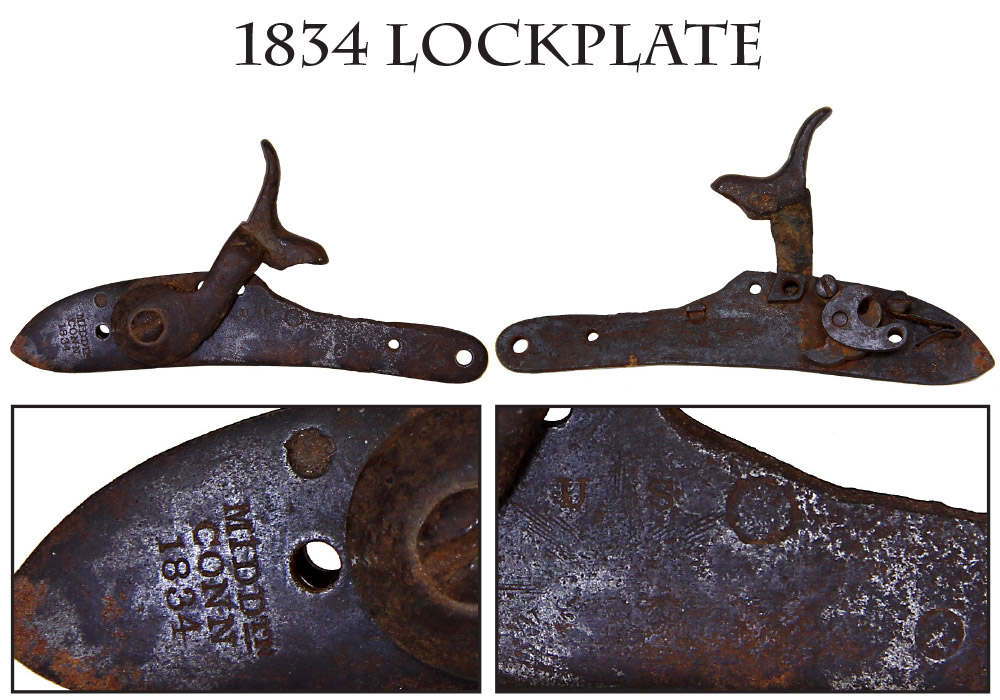
15-06-15 … Nathan Starr 1816 Contract Musket Lock Plate With A Southern Flavor …
A southern picker who sends us stuff from time to time found this at a flea market in his area. It is a lock plate from an 1816 Starr contract musket that still shows the “Middt’n/Conn/1834” date behind the hammer and the U.S. over the starburst forward of the hammer with traces of the “N. STARR” underneath. The hammer shows it to have been converted to percussion in a crude but military looking style. Someone might recognize it as the work of a particular arsenal or southern workshop. I think it’s neat no matter what. Neat southern relic … noco
… $50.00
Click Here to E-mail Us!
Call us @ 419-842-1863
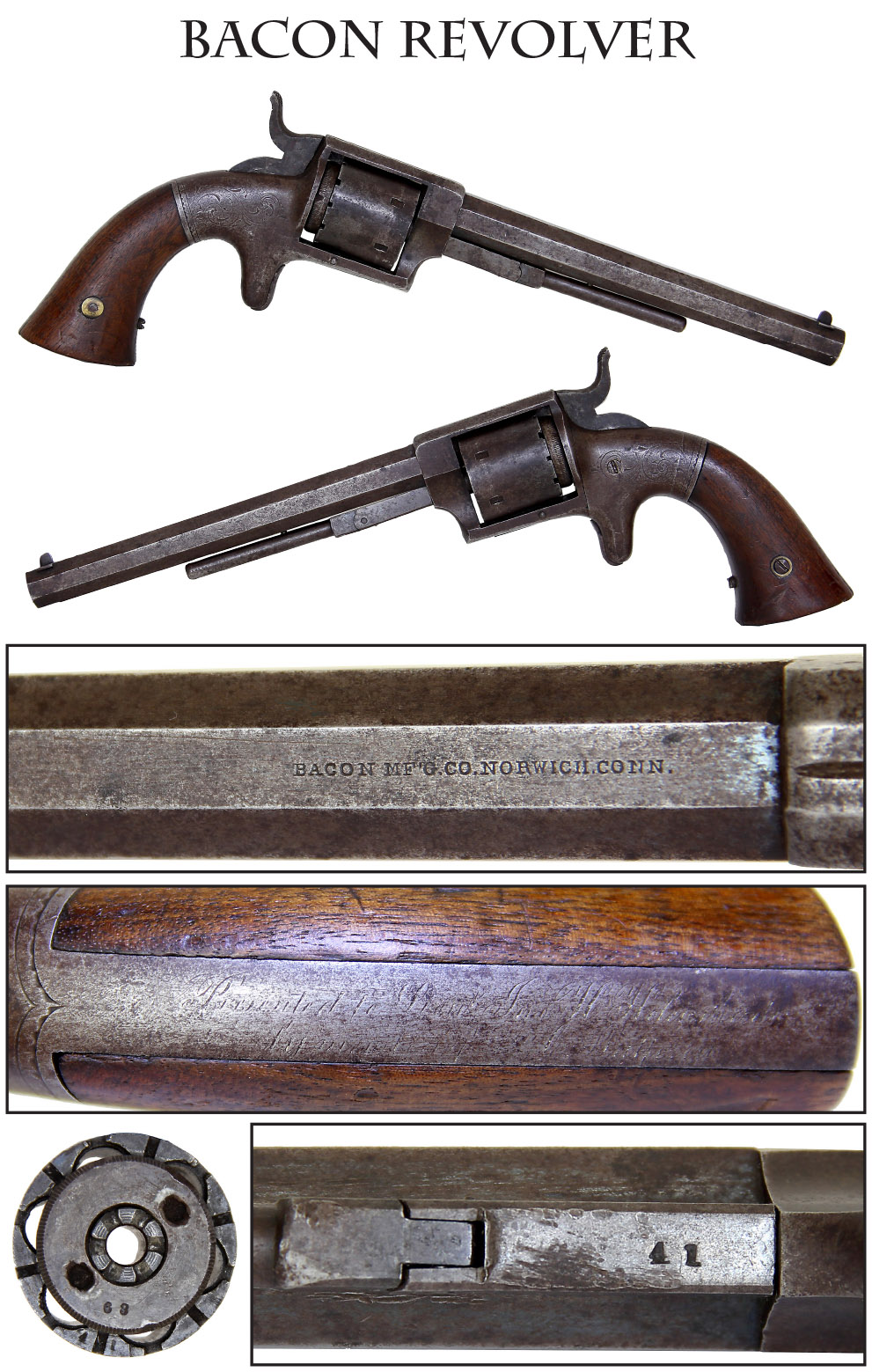
15-06-16 … Presentation Inscribed Bacon Navy Model Revolver …
A very scarce gun in its own right, this one scarcer yet as it is inscribed on the back strap with the Ohio officer’s name that carried it. This is one of the last guns I bought from Uncle Norm Flayderman. It is overall VG condition. Backstrap is engraved… “Presented to Lieut. John H. Holenshade by Members of 5th Ohio Battery”. Records show he served from September 1861 through March 1862. He may or may not have been present at Shiloh. Flayderman thought he was, I cannot verify that. The unit history is … This battery was mustered into service from Aug. 31 to Sept. 20, 1861 at Cincinnati, by Capt. Wilson, to serve for three years. It was filled to a maximum of 170 men, who were forwarded to St. Louis as fast as enlisted. It was actively engaged through the en- tire first day of the battle of Shiloh and lost in this, its first battle, 1 man killed and 20 wounded, 2 pieces, 4 cais- sons, 65 horses, and all camp and garrison equipage. About the middle of September the battery marched with its division to Iuka, but was not in position to take part in the action. It was actively engaged in the battle of Corinth, but suffered no loss. During the siege of Vicksburg the battery was constantly on duty, the position it held being on a prominent hill rather in advance of the general line and the view was uninterrupted for several miles to the right. About 3,000 rounds of ammuni- tion were fired by the battery during the siege and a number of the men were wounded more or less severely but none were killed outright. In the movement that followed against Jackson the battery lost 1 killed and 8 wounded, being posted on an emi- nence from which it kept up a steady fire for some time. It then took part in the movement against Little Rock, Ark. The battery was mustered out July 31, 1865. The revolver lacks a main spring. It appears complete except for that spring. The spring can be manufactured by a competent gunsmith. A scarce pistol with nice inscription, and VERY early war history … exflayd
… $2,500.00
Click Here to E-mail Us!
Call us @ 419-842-1863

15-06-17 … Brass Eaglehead Spurs …
Untouched set of brass eagle head spurs. Mellow patina with some staining and dark spots that would clean up very nicely. The eagle’s head and neck are modeled three-dimensionally and merge into a raised shoulder at the wearer’s heal that dips down and up on either side with a rounded top edge all molded as the eagle’s wings on either side with deeply cast feathers. The wings then transition into rectangular side straps with two narrow channels and slots. The brass rowels are in place and are shaped as round-tipped stars, giving the impression of clouds, with sunburst rays. These were undoubtedly gilt when new and must have been a showy pair. The officer obviously liked them for they show wear, but would clean up very nicely and be an impressive addition to an officer’s grouping. The rowels were replaced in the relatively recent past using 20th century US dimes. I have not encountered this exact pattern of eagle-head previously in any venue. Not as refined as the Schuyler Hartley & Graham eagle-heads, but a more pedestrian grade pair in the same genre
… $550.00 – SOLD
Click Here to E-mail Us!
Call us @ 419-842-1863
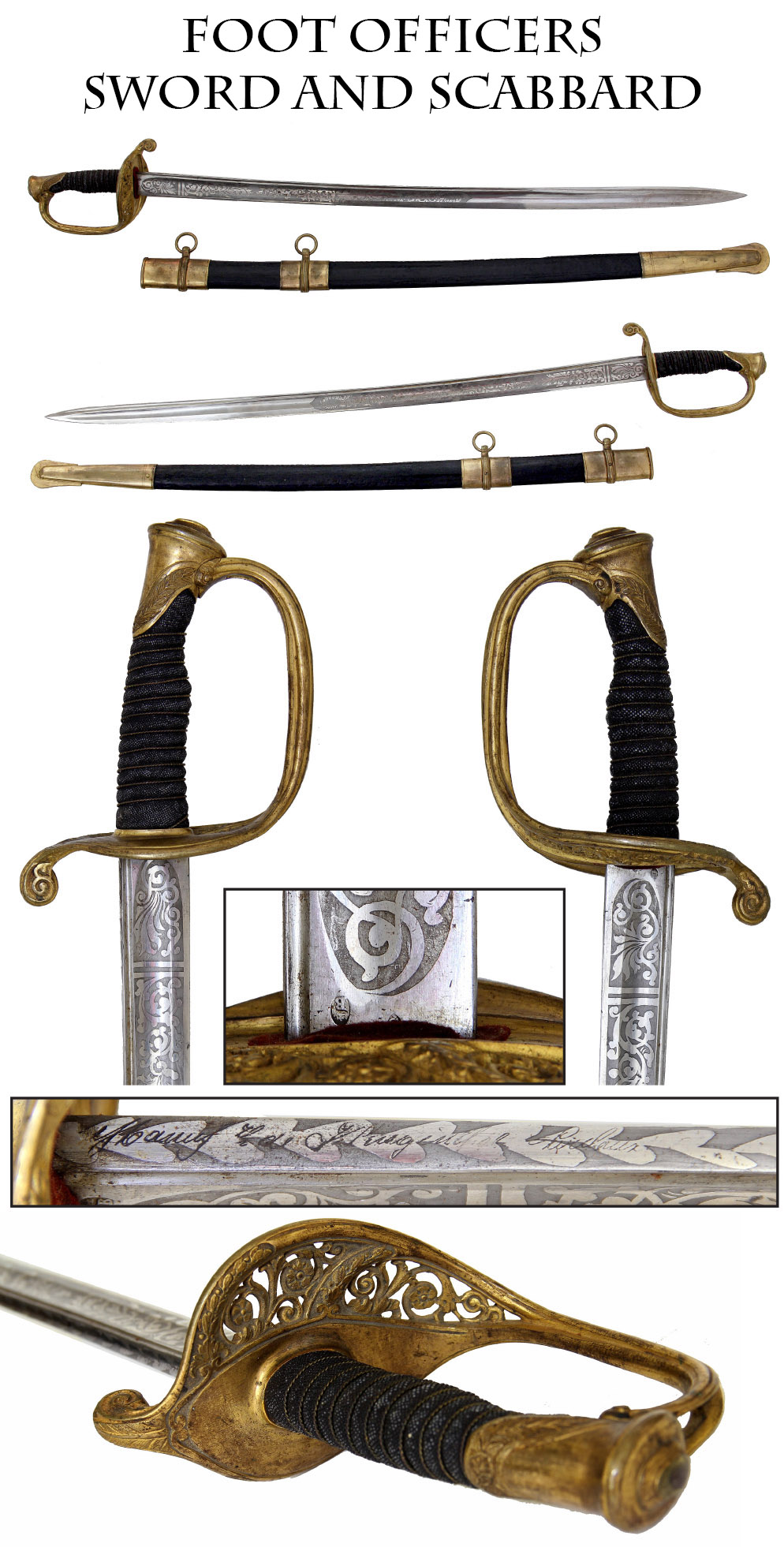
15-06-18 … Klingenthal Import 1850 Foot Officers Sword …
Minty example of a Klingenthal made foot officer’s sword. Our 1850 patterns followed the French designs so it was not a big leap for French manufacturers to produce and ship over here officers’ swords of different patterns. The armory at Klingenthal had been privatized in 1822 and John Thillman shows a number of examples of their exports used over here during the war (CW Army Swords, pp. 339 ff.) This one shows the correct blade inscription on the spine: “Manufre. du Klingenthal Coulaux [& cie.]” with just a little rubbing to the end of the first word and that following the Coulaux firm name. The blade etching on the spine and sides of the blade, however, is vivid and will jump out at you from across the room with flowing vines and etched floral panels. The blade is bright and the edges superb. The sharkskin grip and wire wrap are in place. The black leather scabbard has a good finish and is intact with no bends or breaks, and the brass guard and mounts on the scabbard match in their untouched patina that shows a mixture of light with age-mellowed patina. The cast floral decoration on the pommel cap, knuckleguard, quillon and counterguard are deeply chased and detailed. The pad at the blade shoulder is intact and in place. The blade inspection and proof marks required of the armory, even though it was a private operation, are present at the base of the blade. This is one nice officer’s sword sold by one of the higher class military retailers in the U.S. to an officer with some taste … d-17032
… $775.00 – SOLD
Click Here to E-mail Us!
Call us @ 419-842-1863
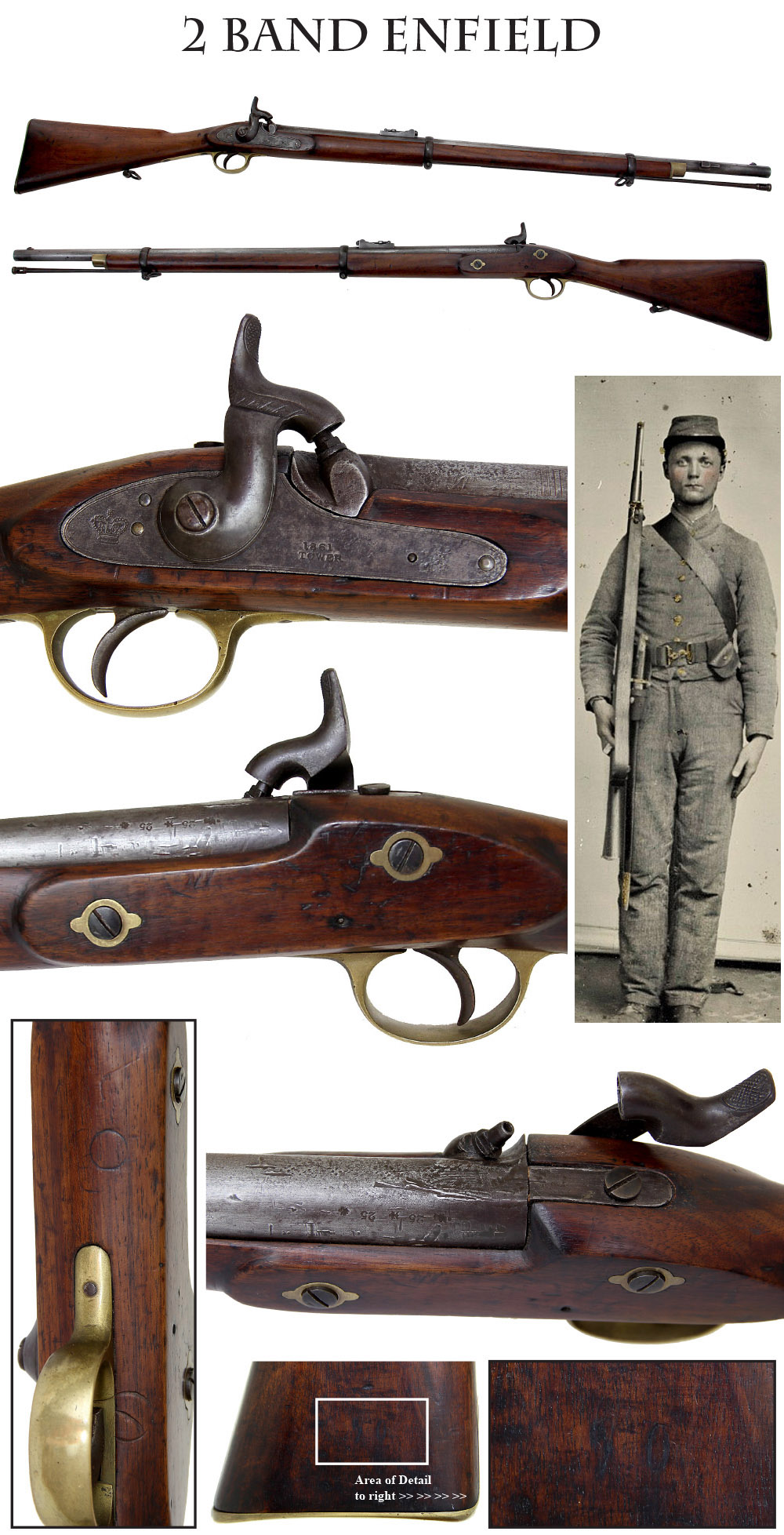
15-06-19 … 2 Band Enfield …
The short Enfield rifles have always been associated with Confederate troops (I remember my old copy of “Company H” that showed an artist’s impression of Sam Watkins holding one.) This is a very nice example with great early war 1861 date over “Tower” forward of the hammer and the crown to its rear. Clear 25/25 breech marks with inspection and view marks on the left barrel at the breech. Some minor marring to the metal at that point from early disassembly. Good wood to metal fit overall with just some slight age shrinkage at the breechplug tang. Metal is a smooth light gray overall with some darker pewter tones here and there. The lock plate shows crisp markings and some mottled color from original case hardening. Very slight corrosion from firing around the nipple and very forward tip of the plate. Slight rounding to edges from actual use and handling. Wood lightly cleaned a long time ago, now mellowing back again. Mellow brass trim, swivels, rod, bands and sights all in place, as is the bayonet stud and guide on the left of barrel at muzzle showing it was intended to mount an impressive saber bayonet. A couple of scratches to the wood. What looks like a circle forward of the triggerguard and an “S” next to it. What seems to be a faint rack number “10” or “70” next to the buttplate on the inside. An attractive rifle that came in when there was still a distinction between light infantry and infantry of the line. This pattern was well liked for its lightness and ease of handling with no sacrifice of accuracy or range. A classic rifle for Confederate display without having to spend five figures for a southern made example … ad-balt
… $2,250.00 – SOLD
Click Here to E-mail Us!
Call us @ 419-842-1863
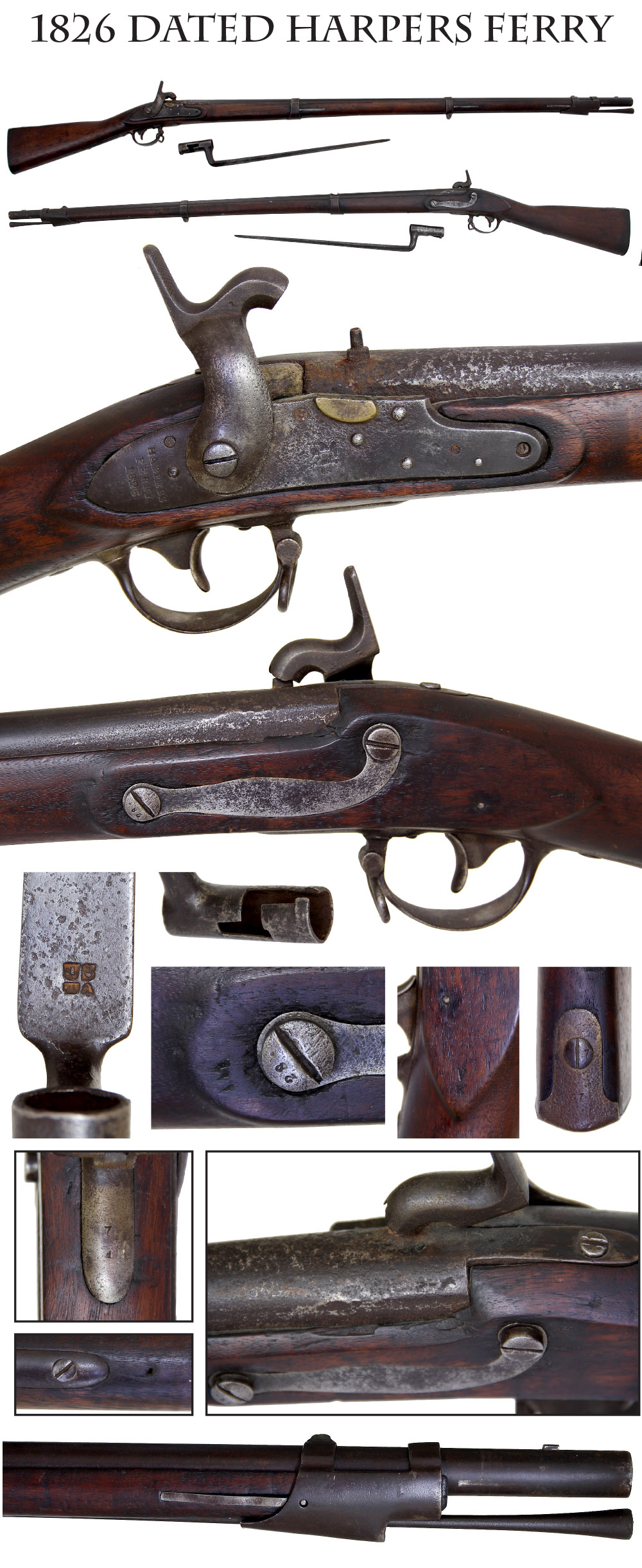
15-06-20 … 1826 Dated Harpers Ferry 1816 Arsenal Conversion and Bayonet …
A decent Harpers Ferry showing all the typical Harpers Ferry inspection and assembly numbers on its parts, even on screwheads. Percussion cone-in-barrel conversion typical of arsenal work that removed the external flintlock parts, shaved off the brass flashpan and filled it, changed the hammer and then forged the breech area to take a nipple directly. This one “saw the elephant.” Corrosion around the nipple from the percussion priming caps show it was fired many times. That having been said, the metal smoothes out from the breech forward and has a nice even brown tone forward matched by the barrel bands and original ramrod. Some slight age shrinkage and divots to the wood, but not bad edges and the conversion reinspection proofs are visible on the offside flat. Bands, springs, swivels, rod and sight in place. With it comes an original 1816 bayonet that shows some light pitting overall and a cut bridge over the mortise but fits well and makes a nice stand of arms typical of an early war volunteer’s outfit. Needless to say, the Harpers Ferry manufacture gives it a strong southern association. With the bayonet … vgcjz-vehjv-16866
… $850.00 – SOLD
Click Here to E-mail Us!
Call us @ 419-842-1863
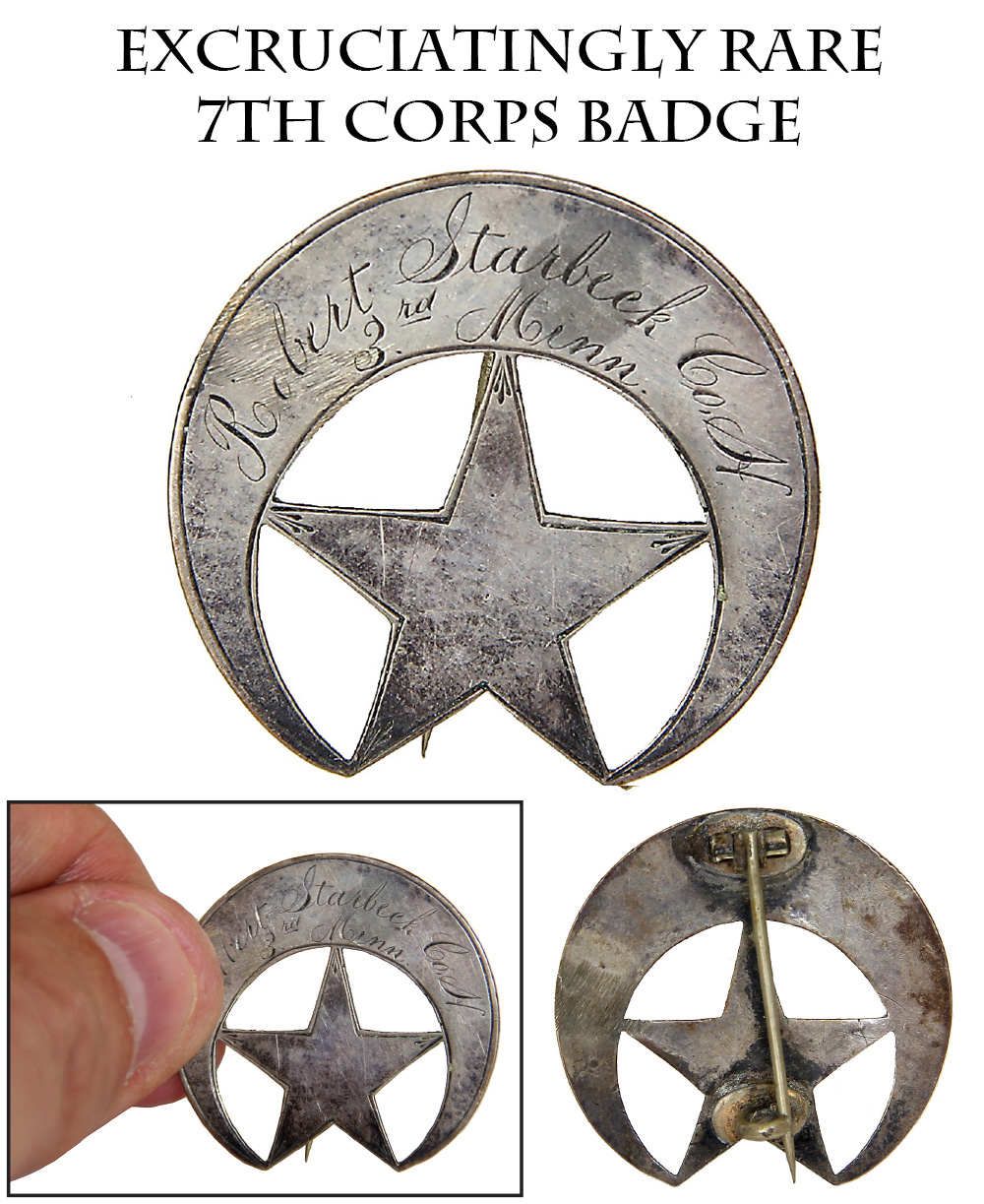
15-06-21 … Third Minnesota Inscribed Seventh Corps Badge …
An extremely rare Civil War corps badge, among the rarest of all wartime corps badges to find inscribed with the soldier’s name and regiment. The Seventh Army Corps adopted the star and crescent as their device, but being in the Department of Arkansas, men in that corps did not have many chances of getting a nice jeweler-made corps badge. Here is nice example of that incredibly scarce badge. Silver crescent surrounding a star (some have the crescent over and others under the star) with a classic T-bar pin on the reverse. Nicely engraved border lines and corner flourishes to the star. Dead-real script engraved name and unit arching across the crescent:
“Robert Starbeck Co. H / 3rd Minn”
Robert F.A. Starbeck shows up in the NPS Soldiers and Sailors database as a private in Company H of the 3rd Minn. A pension application card shows he enlisted 2/27/64 and served until discharged 9/2/65. He was a German immigrant born in 1847 and died 12/6/1923 in Montevideo, Minnesota. The regiment was formed in 1861 and was originally part of the Army of the Ohio, serving at Nashville and Murfreesboro, where it was captured by Forrest. Exchanged in August, 1862, it was sent to Fort Snelling to deal with the Sioux Uprising and was engaged in several marches, fights and skirmishes including New Ulm and Wood Lake. In early 1863 it was sent to Kentucky and Mississippi as part of the 16th Corps. Starbeck joined in time for the regiment’s participation in the expedition to Arkansas, when it became part of the 7th Corps, being present at Bayou Fourche, taking part in the occupation of Little Rock, and engaged in the fight at Fitzhugh’s Woods. At the end of the war the regiment’s Colonel accepted the surrender of Confederate General Jeff Thompson, and the unit was finally mustered out in September, 1865, having lost 17 men killed or mortally wounded. A very scarce unit badge with an individual soldier’s association as well. There are tons of fake corps badges being hawked online, much wiser to buy a real one … noco
… $1,650.00 – SOLD
Click Here to E-mail Us!
Call us @ 419-842-1863
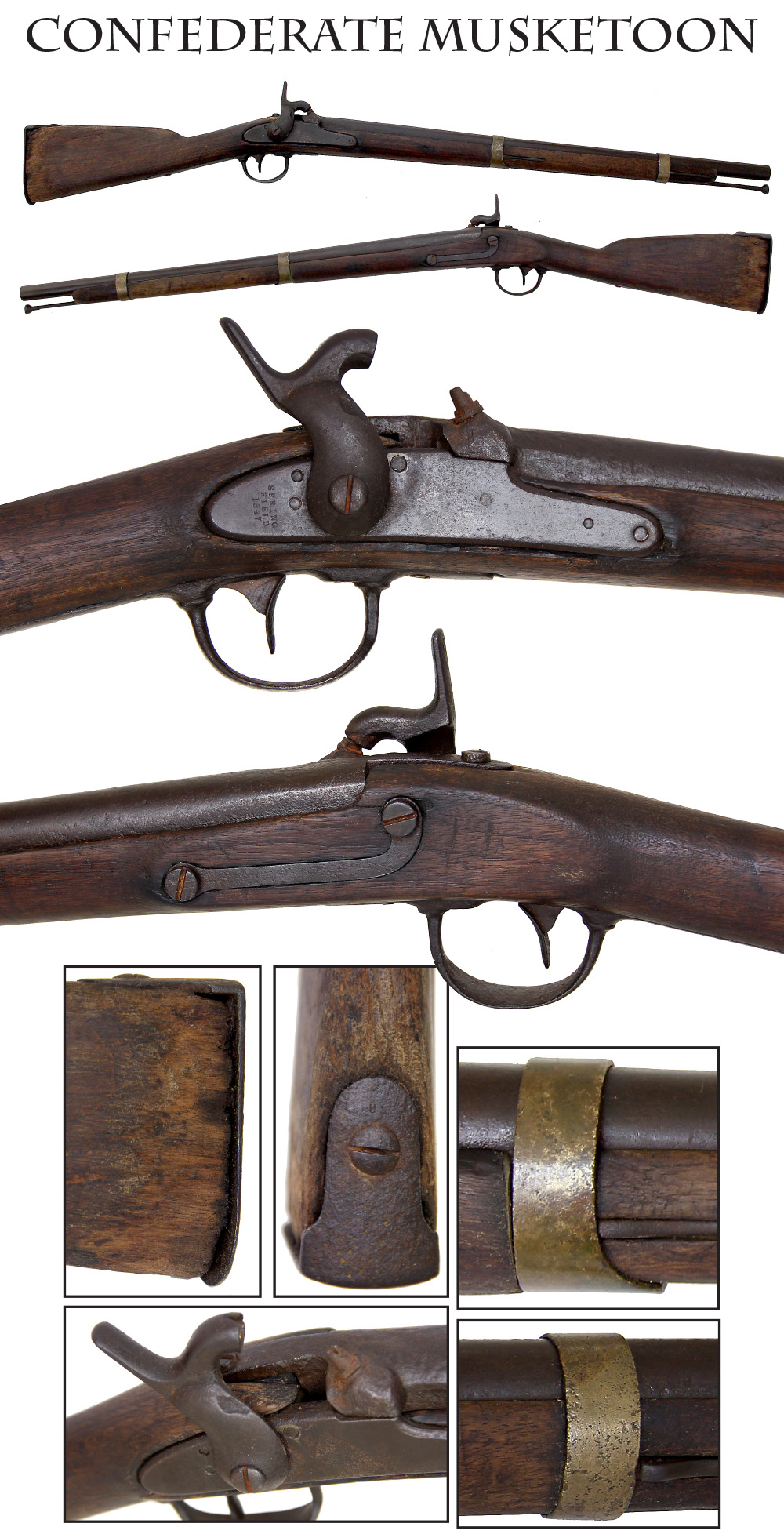
15-06-22 … Confederate Musketoon …
I bought this cut down 1842 musket from a man who got it out of a Virginia junk estate. When I bought it, it was covered in shellac or varnish… absolutely drenched in it. I bought the gun because it clearly has brass barrel bands from a William Glaze Palmetto Armory SC 1842 musket, and I completely believed the seller as to the Virginia source. In addition the value of the two brass bands was about the same as the price I was paying for the entire gun. I had helper Chuck meticulously strip the varnish which took several days. It makes the gun look much better. The stock is two pieces, both being of the original full length stock… This piecing is presumably from the time of shortening. Lots of wear on the wood. Water damage around the butt plate where this clearly stood in a damp corner for decades. All metal brown and pitted. Mechanically VG. A great relic … h-150227
… $1,250.00 – SOLD
Click Here to E-mail Us!
Call us @ 419-842-1863
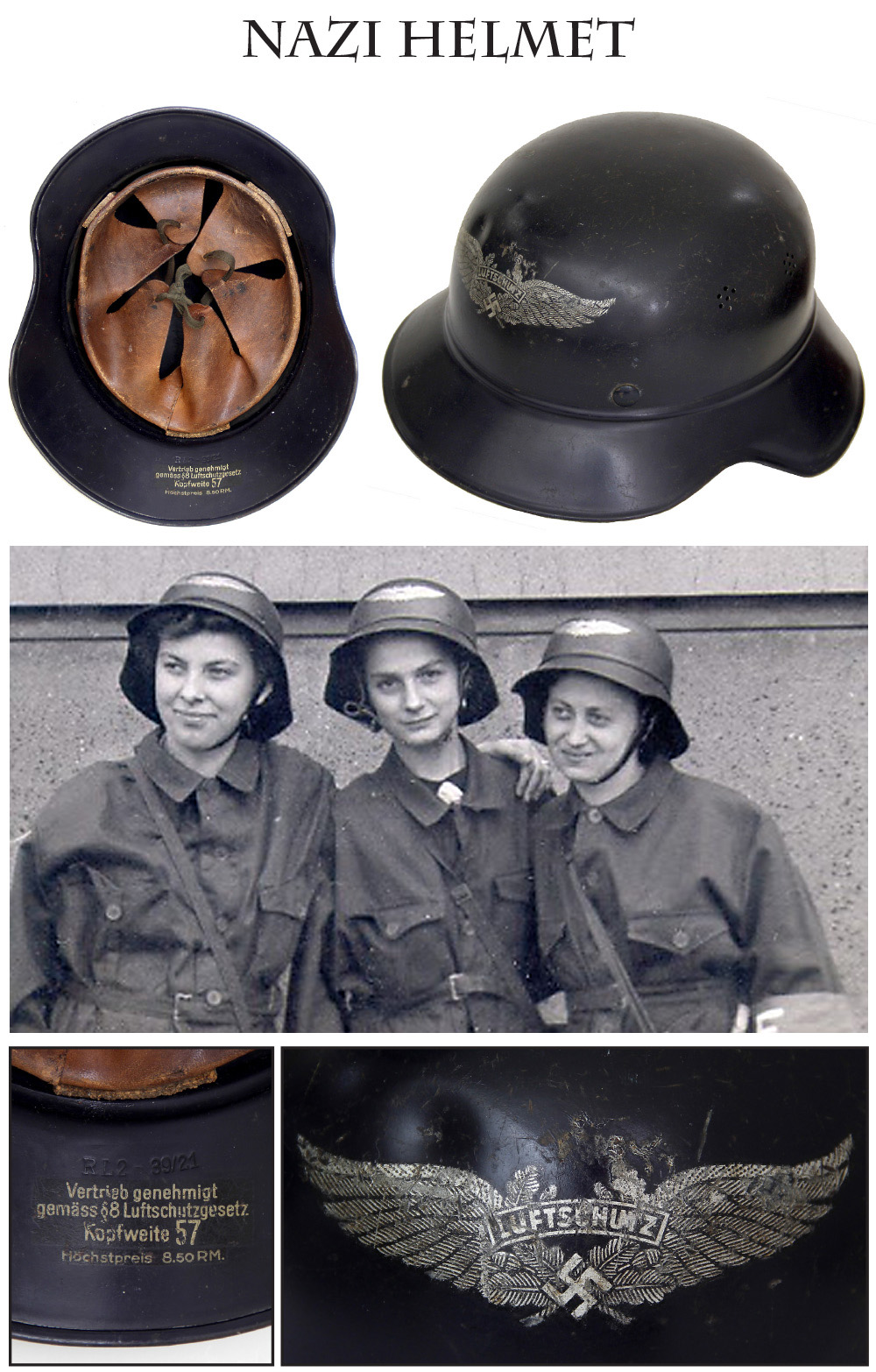
15-06-23 … Extra Fine Condition WW2 German Helmet …
The classic Luftschutz helmet worn by German civil defense members. The luftschutz included women and children. Note the photo… Super condition with full liner
… $265.00 – SOLD
Click Here to E-mail Us!
Call us @ 419-842-1863

15-06-24 … Civil War Import .69 Caliber Rifled Musket and Bayonet …
Patterned on the French 1842 infantry musket, but lacking French arsenal marks and having a bolster somewhat like the French 1857 dragoon rifle, this is likely a Belgian made commercial version of the French rifled musket, typical of the weapons gathered in from European arsenals and arms dealers by American agents of both sides in the early years of the war. Nice wood overall. The metal is brown with some light peppering. Long range rear sight, front sight, bayonet stud, all bands and swivels in place. The rod is a modern reproduction that will do until a period one comes available. With the gun is its correct bayonet. Maker and inspector numbers and initials present. Some light abrasion near the buttplate tang. Some light corrosion near the nipple from firing. A good early war long arm proper to display with US or CS effects. With the bayonet (worth 125 by itself) …. sw-dej … ba-ajj
… $765.00 – SOLD
Click Here to E-mail Us!
Call us @ 419-842-1863

15-06-25 … TWO NICE CDVs FOR ONE NICE PRICE! …
Special Aide to Lincoln / African American Related / Signed CDV of Colonel Le Grand Bouton Cannon, Aide-de-Camp to General Wool, influential in the Union Defense Committee in 1861,
the sheltering of escaped slaves at Fortress Monroe, the enlisting of black troops in the army, and internal army politics. Crisp vignetted bust view of a field-grade officer with flashy sideburns! Cannon was from New York and had served as a volunteer on General Wool’s staff before the Civil War. When most of Wool’s staff resigned and went south, Cannon and a few other prominent New Yorkers joined his staff as volunteers, Cannon acting a volunteer ADC to Wool from April 23 to August 28, 1861. During this period he took an active part in the Union Defense Committee of New York in corresponding with and aiding various northern governors, like the Governor of Illinois, who were trying to obtain arms, etc., and organize without adequate leadership from Washington.
Cannon was officially appointed Major and AADC on Wool’s staff August 28; and Colonel on Feb. 1, 1862. He accompanied Wool to Fortress Monroe, Virginia, which they preserved for the Union. Cannon was involved in formulating the “contraband” policy about escaped slaves who had sought protection at Fortress Monroe and was intimately involved in some of the army’s political infighting. His reminiscences published after the war include a number of first hand accounts of the Monitor and the Merrimac, time spent as a special aide to Lincoln, and experiences with Secretary Stanton, etc. Cannon resigned June 11, 1862, but rejoined Wool’s staff as a volunteer for a time thereafter, until Wool’s retirement in 1863. Cannon’s accounts are a real insider’s view of the doings at various army headquarters. He had been offered the military command of Norfolk, before resigning.
The card is presented to Lt. Col. Whipple, who is probably William Dennison Whipple, West Point class of 1847, who served until 1890, was both ADC and AAG at different points in his career, served on Gen. Hunter’s staff, the staff of General Thomas, and after the war as ADC to Sherman from 1873 to 1878: “Lt. Col. Whipple USA / Asst Adjt Genl / With regards / Le GB Cannon Col / USA & ADC.” Their staff duties had probably brought them into connection at some point, though Whipple was a New Yorker like Cannon.
A significant subject involved in some important early war doings
… AND …
General William F. Smith—He spoke his mind!
Wonderful half-length seated view of the outspoken general in his major-general’s frock coat. Couple minor abrasions to card edge, otherwise excellent. “Baldy Smith” was West Point class of 1845, an officer of engineers until the Civil War, and Colonel of the 3rd Vermont in 1861 serving on the staff of General McDowell at Bull Run. He became a Brigadier General of Volunteers in 1861 and led a division of the 6th Corps on the Peninsula and the Maryland Campaign, and commanded the corps at Fredericksburg. Critical of Burnside and a supporter of McClellan, he was shunted aside in 1863 and sent west, where he ended up feuding with Rosecrans but earning some praise from Grant, and made Major General in 1864. Brought east to command the 18th Corps under Butler, he criticized both Butler and eventually Meade. Accusations that he could have acted more aggressively at Petersburg led to his removal from command in July, 1864. He left the army in 1867, turning to civil engineering and acting as president of a telegraph company and the NY Board of Police Commissioners until his death in 1903. My favorite quote of his was his judgment on Butler: “as helpless as a child on the field of battle and as visionary as an opium eater in council.” He cerrtainly knew how to craft a criticism
… FOR BOTH … $235.00
Click Here to E-mail Us!
Call us @ 419-842-1863
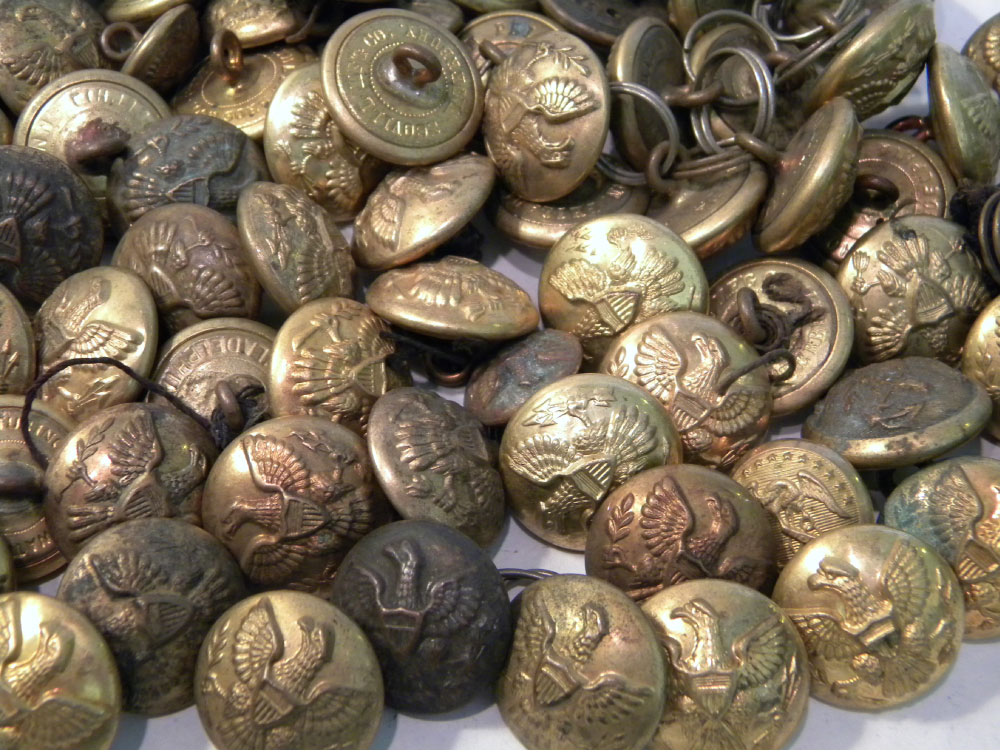
15-06-26 … A lot of TEN Original Indian War Large Size Eagle Coat Buttons.
A few years ago at an eastern Pennsylvania auction I bought a couple large bags full of these early Indian Fighters buttons and then I put them aside and forgot about them. I just stumbled across them again …. So here is a great opportunity…. ten original buttons for $25.00 These can be mailed inexpensively in a padded envelope.
… $25.00 for 10
Click Here to E-mail Us!
Call us @ 419-842-1863

15-06-27 … Friction Primer Tin [Tin not for sale] and Percussion Caps …
I just purchased this neat old relic and am offering the percussion caps inside the tin in this offering. This very scarce tin came just as you see it, filled with percussion caps for muskets. The tin itself is the arsenal tin used to hold artillery friction primers. These are darned hard to find! I can only think of one instance where I found one still in a primer pouch! The tin has a hinged cover with small latch and embossed top reading: 100 FRICTION PRIMERS in an arc over an ordnance insignia, and FRANKFORD ARSENAL on either side. I don t know who put the percussion caps in the tin, it was certainly a handy storage idea, but since they do not belong together, I am splitting up the lot.
In each package of ten cartridges the soldier got 12 caps. While the supply lasts I will sell the percussion caps …
One Dozen … … … $15
Two Dozen … … … $25
Five dozen … … … $50
Click Here to E-mail Us!
Call us @ 419-842-1863

15-06-28 … These buttons were patented in 1862 by Abel Putnam
and made with a long spring shank and were designed to go through the grommets on issue rubber blankets so the sides could be connect ed and the whole thing worn as a poncho in rainy weather.The face is a standard Union Army eagle button. The back is a spring hook fashioned from double spring steel wire. I have very few priced each at
… $45.00
Click Here to E-mail Us!
Call us @ 419-842-1863
Layaways are Welcome
Need to split your order into multiple payments? No problem! A simple 20% earnest money deposit will hold your item for you.-acf
You can then pay it off in easy installments that fit your budget.
Read Terms Here
Items to Sell? Contact Us
I am always interested in buying ANYTHING from the American Civil War… Guns, Swords, Civil War Muskets, Knives, Uniforms, Flags, Medals, Badges, Diaries, Letters, Autographs, Buttons, photographs, tintypes, daguerreotypes, Insignia, Camp Items, Battlefield Relics, canteens, Drums, Etc… Call 419-842-1863 and ask for Dave Taylor.

